Research Article - (2022) Volume 8, Issue 1
A COVID-19 Hub for Zimbabwe
1Department of Surveying and Geomatics, Midlands State University, Zimbabwe
*Correspondence:
Kumbirai Nicholas Matingo, Department of Surveying and Geomatics, Midlands State University,
Zimbabwe,
Email:
Received: 03-Jan-2022, Manuscript No. IPJPIC-22-12431;
Editor assigned: 05-Jan-2022, Pre QC No. IPJPIC-22-12431 (PQ);
Reviewed: 19-Jan-2022, QC No. IPJPIC-22-12431;
Revised: 24-Jan-2022, Manuscript No. IPJPIC-22-12431 (R);
Published:
31-Jan-2022, DOI: 10.36648/2471-9668.21.7.82
Abstract
Like the rest of the world, Zimbabwe has been suffering from the effects and conditions associated with the
Coronavirus (COVID-19) pandemic since March 2020. Throughout this period, citizens require information,
knowledge, and understanding about the virus including the measures that have been implemented by the government
in the fight against the pandemic. Decision makers need data analytics to make informed decisions on
policies and moreover, tech persons also require resources that can assist them in building solutions in the fight
against the pandemic in this technology era.
The COVID-19 Hub for Zimbabwe house’s location based, informative, raw data and analytical resources that
help the citizens, decision makers, and persons in the technical fields to fight against this deadly virus which has
claimed more lives over the past year. Citizens can also easily find resources using location intelligent applications
contained within the hub (i.e., Vaccine Finders and COVID-19 Testing Centres). The solutions include dashboards,
raw datasets, and visual informative tools for the republic of Zimbabwe. Moreover, through the ArcGIS API, we
have managed to share external integration which leverages our data and resources into other innovative solutions
by the Youth in Zimbabwe to promote and use Information Communication Technology (ICT) in the fight
against COVID-19.
Introduction
Like every other country in the world, Zimbabwe has not been
spared from the global Coronavirus pandemic. As of 12 January
2022, the country has recorded a total of 224,433 confirmed
cases of SARS-CoV-2, the virus that causes COVID-19. In addition,
a total of 3,207,302 citizens including foreign nationals
had also been fully vaccinated against this deadly virus marking
21.09% of the population that is immune.
The government of Zimbabwe has also adhered to strict measures
recommended by the World Health Organization (WHO)
to curb the spread of COVID-19. Some of these recommendations
include the compulsory wearing of face masks, social
distancing, minimizing travel among others [1]. The coming of the vaccines has played a major role in the reopening of the
economy allowing businesses to operate but still under strict
protocols following the statutes that have been put into place.
To help the nation, move forward and plan, we need to rely on
past and present data to make the best decisions for humanity.
The COVID-19 Hub for Zimbabwe provides up to date data on
the COVID-19 situation in Zimbabwe. Not only does the platform
provide data for analysis, but it also provides a set of tools
and applications that are being used by the public.
The data contained is constantly maintained and updated daily
based on the official updates provided by the Ministry of
Health and Child Care through their Twitter handle and other
official communication channels [2].
Multiple sources of data focusing on the COVID-19 pandemic
exist over the internet, where dashboards are reporting the daily
increase and progression including tracking and monitoring
of the vaccine roll out initiatives to achieve world herd immunity
[3,4]. A more strategic approach that does not generalize the
situation is however required to solve a nation’s problem. In this
case, Zimbabwe specific data is available on the COVID-19 Hub
for the Zimbabwe platform.
Our data has been tracking the progression and trends since the
first case was recorded in the country on the 23 of March 2020.
The platform also provided location dependent applications
and tools that help the public understand what is going on and
where to find resources for their health and safety. As the need
for reliable, authentic, and correct information is of importance
throughout a pandemic, our platform also caters to those needs
by curating information from verified sources [5].
Essential geolocation tools like the vaccine finder and COVID-19
testing center finder which reside within the platform have also
contributed to assisting the public in easily finding, planning,
and navigating to the closest health center for vaccination and
PCR testing. In the early stages of the vaccine rollout program,
only a limited number of facilities were provisioned to offer a
dose of the vaccine hence providing challenges and doubts as
to whether the vaccine would be available at their closest facility.
With the world finally realizing the important role of data in
policymaking and development strategies, the COVID-19 Hub
for Zimbabwe is also supporting scientists, analysts, and policymakers
in the country in this process [6]. We have also provided
developer documentation that helps promote innovation
during these times. Technically skilled persons, especially the
youth, are leveraging this data to develop solutions that combat
COVID-19 at the lowest levels (community) taking a bottom up
approach until the whole nation is reached.
Our COVID-19 dataset is currently being used by journalists,
media houses, policymakers, developers, and the public. Media
houses like Pindula have included our infections dashboard
on their COVID-19 updates page (https://news.pindula.co.zw/
coronavirus/) to spread awareness and information on the
status of the situation. The Ministry of Health and Child Care
of Zimbabwe (MoHCC) also utilizes our digitized data for their
coronavirus dashboard (http://pillars.mohcc.org.zw:2020/
covid19-pillars/).
Local businesses in Zimbabwe are utilizing this data for business
operations as they plan on managing their staff for effective
business production during such a time [7]. By knowing where the
current surge is and is most likely to occur, businesses, individuals,
and government institutions can plan ahead.
The COVID-19 Hub for Zimbabwe also carries a set of applications
that promote citizen participation and engagement in the
making and management of policies in the country. One such
application which is based on geographic data is the vaccine
experience survey application. By asking the public a series of
questions on the vaccination process in the country, policymakers
and analysts can recommend the next course of action to
improve outreach strategies towards achieving the required
herd immunity of at least 70% [8]. This will also ensure the protection of the most vulnerable and non-eligible members of the
community.
The data dashboards that present a visual explanation of the
pandemic have been the public’s main attraction and interest,
as visually displayed information is critical in times of crisis to
assist the public to better understand and make sense of the
situation [9].
Methods
The COVID-19 Hub for Zimbabwe consists of three segments
which are the data, the location applications, and the data API.
All these segments are delivered under the open source initiative
through the support of different service providers such ESRI
and NivaCity (for additional hosting and cloud services).
Data
The data is collected from the daily sitreps provided by the Ministry
of Health and Child Care of Zimbabwe and is entered using
an ArcGIS Survey 123 applications. The application then directly
feeds into the main database which in this case is a Feature
Hosted layer in an ArcGIS Online Organizational account.
The data is then fed into different dashboards developed to display
different kinds of information and visualization.
The main data used in the COVID-19 Hub for Zimbabwe consists
of the following:
Daily infections trend: This data contains the daily trends and
statistics recorded for all confirmed infections, recoveries,
deaths including hospitalizations within the country.
Daily vaccinations trend: Like the infections daily series trend,
this dataset contains information about vaccination information
and statistical data daily.
Provincial time series: This data breaks down all the nation’s
provinces to record a daily statistic of the number of PCR and
Ag tests conducted including several confirmed and reported
cases, recoveries, deaths, and the currently active cases.
Provincial cases: The dataset contains the static value of the situation
in every province about the total number of cases, recoveries,
deaths and provides the ratio of the population affected
by the pandemic in each province.
In efforts to spread the use and discoverability of the data, we
have also added it to the African Surveyors Connect GitHub repository
(https://github.com/African-Surveyors-Connect/Zimbabwe-
COVID-19-Data). The main format of the data is in CSV
format.
Location Applications
The location applications rely on both crowdsourced data and
available public datasets which also include health facilities in
Zimbabwe.
The applications are built leveraging ESRI’s ArcGIS Online technology
for building web applications that are mobile responsive.
All these applications are based on the data curated from
official and public sources.
Algorithms such as the closest facility are embedded within the location applications such as the Vaccination Center Finder and
COVID-19 Testing Center Finders. This helps the users easily find
the shortest path with the minimum cost to travel to and from
to get the vaccine shot and also for COVID-19 testing purposes
[10].
Geocoding is also an essential component that constitutes the
location applications found within the COVID-19 Hub for Zimbabwe.
These allow for the user’s input data to be easily translated
into a coordinate about a place and pave way for processes
to follow such as the closest facility operations [11].
The COVID-19 Hub for Zimbabwe has been hosted online and is
freely available to the public (https://covid19.africansurveyors.
net/).
Data API
To cater to the need to analyze and build innovative solutions
during this period, we provided an access point for the data by
leveraging the already existing ArcGIS Python API.
The data (feature layers hosted in ArcGIS Online) were made
publicly available for access through the API. Our data varies
and contains different metrics in each dataset provided for public
usage. These metrics have been defined in our project documentation
for developers and scientists [12]. This documentation
has been hosted on Read the Docs for easy accessibility to
the community (https://zimbabwe-covid-19-data.readthedocs.
io/en/latest/).
Code Availability
We have managed to make some of the scripts used in the process
open-source. These can also be located in the GitHub repository
(https://github.com/African-Surveyors-Connect/Zimbabwe-
COVID-19-Data) and are mainly based and dependent
on the Python programming language by leveraging the ArcGIS
API for Python.
We intend to produce additional tutorials on how users can perform
certain tasks and queries with the data.
Results
Provincial Coverage of Fully Vaccinated People
All provinces in Zimbabwe have adopted the vaccination campaign
and drive towards achieving herd immunity. As of 12 January
2022, Zimbabwe had a cumulative total of 4,183,395 people
who have received the first dose of the COVID-19 vaccines
available in the country and at least 3,207,309 have received
both doses. Additionally, 18,763 have received booster shots in
protection against the emerging variants of the virus. This entails
that 21.09% of the population have been fully vaccinated,
while 27.51% have received a single dose. The booster shots
have only covered 0.58% of the fully vaccinated population.
Figure 1 shows the percentage distribution of the fully vaccinated
population in every province in Zimbabwe as of 12 January
2022.
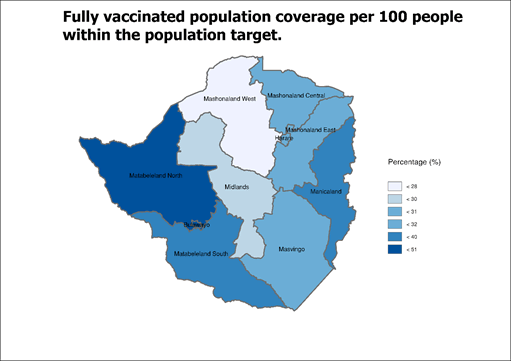
Figure 1: Percentage distribution of the fully vaccinated population in every province in Zimbabwe as of 12 January 2022
All provinces have coverage less than 51% that have been fully
vaccinated whereas Matabeleland North province has the most coverage within the country. Mashonaland West province,
however, has the lowest coverage of fully vaccinated people
within the country. Masvingo, Harare, Mashonaland Central,
and Mashonaland East have fairly and almost equal coverage of
.
the fully vaccinated target populatio.
Trend Variation over Time
With the different surges and occurrences of different variants
of COVID-19 in the world, Zimbabwe has also experienced peak
times where there are more confirmed and reported cases than
other days. Figure 2 shows the different peeks experienced in
Zimbabwe to date.
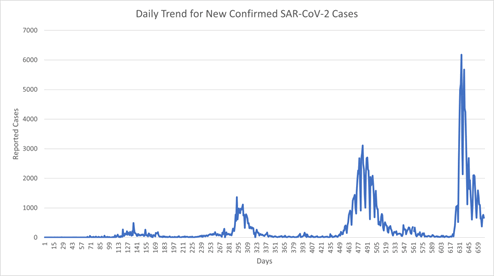
Figure 2: Different peeks experienced in Zimbabwe to date
The peeks for the different COVID-19 variants Alpha, Beta, Delta,
and Omicron are seen to begin their surge at days 99, 253,
435, and 617 respectively. With each coming of every variant,
the total number of people infected daily increases. To date,
the Omicron variant has the most reported daily cases in Zimbabwe.
Most of the vaccine dose is increased during peak times of the
pandemic as can be shown in Figure 3.
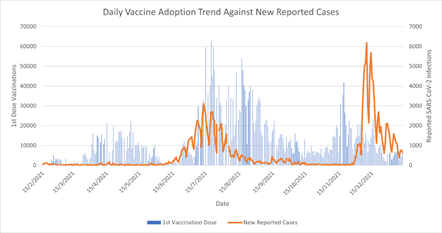
Figure 3: Daily increase in confirmed cases and the vaccine uptake since the first dose of the SARS-CoV-2 vaccine was administered in the country on the 18th of February 2021
Figure 3 shows the daily increase in confirmed cases and the
vaccine uptake since the first dose of the SARS-CoV-2 vaccine
was administered in the country on the 18th of February 2021.
This also shows a slow uptake during the early initiation days of
the process in the country.
Public Participation
Through the My Vaccine Experience survey, a sample size of 118
responses was used to compare waiting times across the country
based on the population that had been vaccinated. Figure 4
shows that most people had to wait between forty minutes to
an hour to receive a shot of the vaccine.
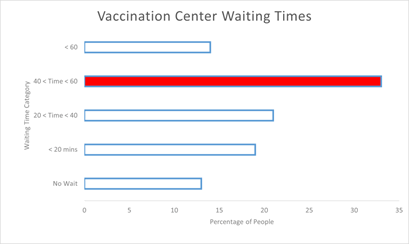
Figure 4: Most people had to wait between forty minutes to an hour to receive a shot of the vaccine
A small portion of people does not have to wait at all. The locations
of the vaccination centers with the most waiting times can
be observed in Figure 5.
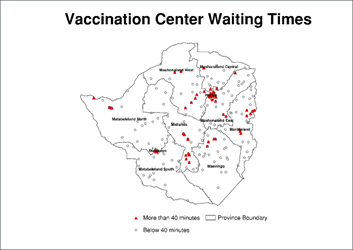
Figure 5: The locations of the vaccination centers with the most waiting times can be observed
Harare Province, where the most population resides, has the
longest duration of waiting times in the country followed by Bulawayo
which also has a high population. Matabeleland South
did not record any responses of people that have experienced
any long duration of waiting times while Masvingo, Matabeleland
North, and Mashonaland Central have a few facilities that
have recorded waiting times exceeding forty minutes.
Geolocation and Navigation Apps
The public has been provided with navigation tools such as the
vaccine and testing center finder which provide locations and
directions to the nearest vaccination or testing centers based
on the user’s choosing. Figure 6 displays a response rendered
by a user looking for a vaccination center closest to them.
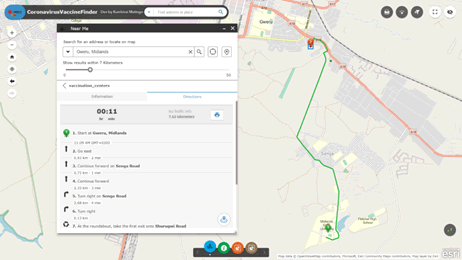
Figure 6: Response rendered by a user looking for a vaccination center closest to them
The application which is connected to the COVID-19 Hub for
Zimbabwe provides the users with additional options to print
their destination maps and search for centers in other different
locations. The user can either choose to have their current
location as the starting point or a different location within Zimbabwe
thereby also specifying the amount of distance in kilometers
as their search radius.
Discussion
The COVID-19 pandemic came at a time when most developing
countries like Zimbabwe and the rest of the world were not
prepared. Roberts et al suggest that the virus emerged in China
in early October and mid-November 2019 and developed into a
global pandemic in the early days of 2020 [13]. Zimbabwe then
later on recorded its first case of the Coronavirus on the 20th of
March 2020 [14]. By the time the first case was recorded, the
nation was already in lockdown as a preventive measure to curb
the potential spread.
The lockdown however did not stop SARS-CoV-2 from entering
the country through returnees who were fleeing from different
countries [15]. As can be seen in Figure 2 the first wave of the
virus consisted of cases below the daily margin of 500. The induced
lockdown which lasted for months worked in the nation’s
best interest. However, as new variants started coming in, this
wasn’t the case anymore as the daily cases begin to rise with
each variant.
During these times of need and panic, our COVID-19 Hub which began operating a week after the first case was discovered provided
data, information, and location support to the nation. The
coronavirus was unforeseen and was a new disease while most
citizens needed answers to understand the situation developing
each day. Through the data dashboards located in the Hub, people
could understand, track, and monitor the development of
the situation at the same time have answers to their questions
in a visual manner.
The rapid development of effective vaccines against SARSCoV-
2 was a huge achievement in 2020 for the medical industry
[4]. Zimbabwe was fortunate enough to receive doses of the
vaccine in February 2021 setting the pace for the vaccination
drive in the country which began on the 15 of February in the
same month. The initial uptake of the vaccine was slow during
the early stages and was later sped up by the increase in daily
new cases as indicated in Figure 3. The increase in the vaccine
uptake during times when infections are on the increase also
suggests increased efforts by relevant authorities to speed up
the process to achieve herd immunity while the public responds
positively to the call during such times.
To support these efforts, the COVID-19 Hub for Zimbabwe houses
the Find A Vaccine location based tool which helps anyone in
Zimbabwe to easily find the quickest vaccination sites which are
closest to them. Figure 6 Displays the frontend interface to the
tool. In addition to providing the location of centers, the Find a
Vaccine application also provides the user with the best route
to their intended destination while also providing an option for
printing out the directions map for sharing or offline navigation.
While the vaccination efforts were increased through the application
and different approaches by various organizations and
institutes, the Hub provided a means for the users to provide
their input as a way of public participation. This voluntarily
acquired data is then shared with relevant authorities to conduct
analysis and see how different approaches can be used to
strengthen the efforts and increase vaccine uptake in line with
the herd immunity targets set by the government of Zimbabwe.
Figure 4 suggests that from the sample taken, most people
waited longer than 40 minutes for them to get a shot of the vaccine
in Zimbabwe. Figure 5 displays the locations of the centers
in which most respondents who spent more than 40 minutes
in the queue to get the shot were located. The question now
remains to the relevant authorities as to what can be done to
reduce the amount of time spent in line waiting for the vaccine.
A study in the United States shows that most people preferred
not to wait long enough to get inoculated [16]. Waiting too long
inline also has its side effects which could lead to one getting
infected with the virus during the process.
Figure 1 displays the result of the vaccination efforts in Zimbabwe
as of 12 January 2022. The targets that were set by the
Ministry of Health and Child Care of Zimbabwe are dependent
on the number of people living in the certain province who are
eligible for the COVID-19 vaccine based on the available doses
in the country [2]. Provinces like Matabeleland North have
a high coverage per 100 people due to their low population in
the province. Much of the population of the country resides in
the capital city (Harare) which has an average coverage of fully
vaccinated people. More efforts are however required in Mashonaland
West to speed up the process and achieve the intended targets set by the Government through its health ministry.
Our dataset and the COVID-19 Hub for Zimbabwe help the nation
including policymakers and decision makers better understand
the trends to make the right decision based on the occurring
trends from real time data.
Limitations
The lowest level contained in the dataset ends at the provincial
level whereas the lowest administrative level in Zimbabwe is at
the ward level. This leads to the generalization of the occurring
trends in every part of the country. Moreover, trend occurrence
and highly accurate hotspot analysis are more effective
when the data is managed and collected at the household level
giving a clearer vision of how the virus is spreading from place
to place. The generalization at the provincial level can lead to
some bias and inappropriate policies for some regions and divisions
within the country.
Another limitation is the data that is received from the Ministry
of Health and Child Care of Zimbabwe daily which comes as
either PDF or in image format. This data is manually entered
into the system daily which could lead to some minor errors
thereby deviating from the actual values and statistics if data is
left unrevised and unmonitored. Having this data in digital format
would pave way for the development of data mining tools
that automatically populate the database which feeds multiple
systems within the COVID-19 Hub for Zimbabwe.
Lastly, no information is provided from vaccination sites that
could help people seeking the vaccination shot to better understand
and schedule their visits to the center. Most people
get the vaccine in Zimbabwe on the assumption that the center
could have fewer people seeking the same service on a particular
day due to certain factors.
Acknowledgment
We would like to acknowledge the work being done by the Ministry
of Health and Child Care (MoHCC) of Zimbabwe throughout
the COVID-19 crisis by providing us with the much needed
data and support for implementing this solution for the nation.
I would also to acknowledge my learning institution Midlands
State University, for providing the support and guidance
throughout the implementation phase and lastly, I would like
to thank my parents Mr. and Mrs. Matingo, for their support,
motivation, and assistance thus far. We would not have done
this without them.
Conflict of Interest
There is no competing interest.
Source of Funding
No funding was provided for the author.
REFERENCES
- Advice for the public on COVID-19 â?? World Health Organization.
- Ministry of HealthZW (@MoHCCZim) / Twitter. Twitter.
- Dong E, Du H, Gardner L (2020) An interactive web-based dashboard to track COVID-19 in real-time. Lancet Infect. Dis. 20:533â??534.
[Cross Ref] [Google Scholar] [Research Gate] [PubMed]
- Edouard M, Hannah R (2022) A global database of COVID-19 vaccinations | Nature Human Behaviour.
[Google Scholar] [Research Gate]
- Bernardino M, Bacelar NL (2020) The importance of reliable social media information during the COVID-19 pandemic. Eur. J. Public Health 30: 165-067.
[Cross Ref] [Research Gate]
- Jonathan G (2022) Data and Covid-19: Navigating Barriers to Data-based Policy-making. TReNDS.
- Iyaniwura SA, Rabiu M, David JF, Kong JD (2021) The basic reproduction number of COVID-19 across Africa.
[Google Scholar]
- Delicado A, Rowland J (2021) Visual Representations of Science in a Pandemic: COVID-19 in Images. Front. Commun. 6.
[Cross Ref] [Google Scholar]
- Roberts DL, Rossman JS, JariÄ? I (2021) Dating first cases of COVID-19. PLOS Pathog. 17: e1009620.
[Research Gate] [Google Scholar]
- An interactive web-based dashboard to track COVID-19 in real-time
- Murewanhema G (2020) A descriptive study of the trends of COVID-19 in Zimbabwe from March-June 2020: policy and strategy implications. Pan Afr Med J. 37.
[PubMed] [Cross Ref] [Research Gate]
- Eshun WI (2021) Preferences for COVID-19 vaccine distribution strategies in the US: A discrete choice survey. PLOS ONE .16:e0256394.
[Cross Ref] [Research Gate] [Google Scholar] [PubMed]
- Pawlowski A (2022) Can you get COVID-19 standing in line? How to lower risk.
- Closest facility analysis-ArcMap | Documentation. (2022)
- Library Guides: GIS (Geographic Information Systems): Geocoding. (2022)
- Home - Zimbabwe COVID-19 Data. (2022)
Copyright: This is an open access article distributed under the terms of the Creative Commons Attribution License, which permits unrestricted use, distribution, and reproduction in any medium, provided the original work is properly cited.







